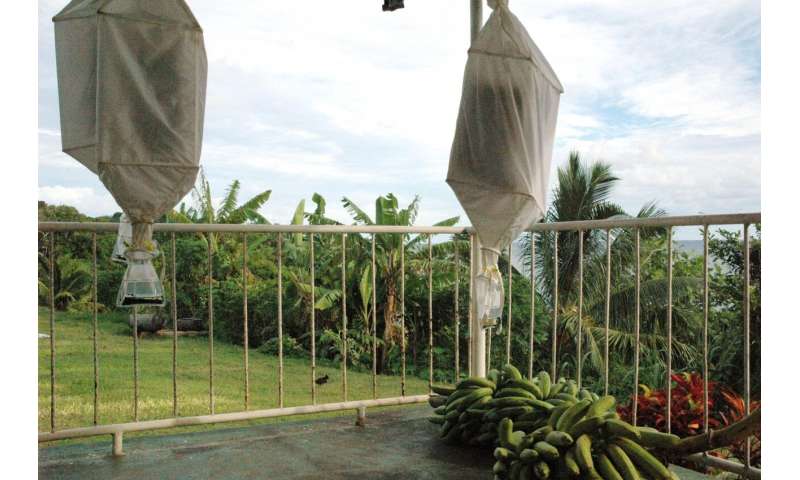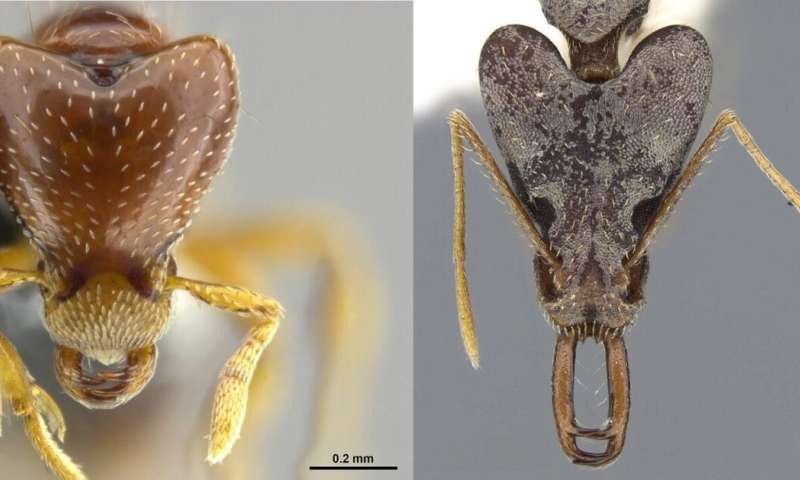by Okinawa Institute of Science and Technology

The scientists used Winkler traps to extract the trap-jaw ants out of leaf litter into flasks of ethanol. Credit: OIST
For millions of years, remote islands have been hotbeds of biodiversity, where unique species have flourished. Scientists have proposed different theories to explain how animals and plants colonize and evolve on islands but testing ideas for processes happening over long time scales has always been a challenge.
Recently, cutting-edge techniques in DNA sequencing, 3-D imaging, and computation have opened up opportunities for investigating historical processes. In a new study published in Evolution, researchers from the Okinawa Institute of Science and Technology Graduate University (OIST) and collaborators from the University of the Ryukyus investigated evolutionary and ecological changes in ants in the South Pacific archipelago of Fiji to examine a controversial theory for how evolution occurs on islands.
"Islands like Fiji, which are small and remote, act as perfect natural laboratories to study the interplay between ecological and evolutionary processes," said Dr. Cong Liu, first author and former Ph.D. student from the OIST Biodiversity and Biocomplexity Unit. "But until recently, there haven't been many studies on ants."
The team focused on Strumigenys trap-jaw ants, the genus with the greatest number of ant species in Fiji. They collected many specimens of trap-jaw ants during an expedition to Fiji in 2007.
The researchers set out to examine how well the changes in appearance and distribution observed in trap-jaw ants over time fit with a theory called the taxon cycle hypothesis, which describes how species colonize and evolve on islands. According to this theory, species pass through a predictable "life cycle" of colonization, geographic range expansion, decline, and (sometimes) extinction, with this cycle then restarted by a new colonizer.
Cracking the colonization stage
The scientists extracted and sequenced DNA from Strumigenys species endemic to the Fijian archipelago—in other words, they are only found in these islands. The team also included samples of the trap-jaw ants more regionally and globally distributed relatives. Based on the DNA sequences, the scientists constructed an evolutionary tree, showing how closely related all the species were.
"We discovered that all 14 of the trap-jaw ant species endemic to Fiji were descended from a single original colonizer, rather than from multiple colonizers," Dr. Liu explained.
These results contradict what would be expected by the taxon cycle hypothesis, which predicts that later colonizers arrive and kickstart new taxon cycles of radiation and decline.
"There are a few reasons why repeated colonizations may not have occurred," said Dr. Liu. He explained that the first trap-jaw colonizers could have diversified and occupied all the niches, closing the door to any newcomers. Or perhaps, he added, the Fijian archipelago is so remote that additional colonizers never arrived.

For millions of years, remote islands have been hotbeds of biodiversity, where unique species have flourished. Scientists have proposed different theories to explain how animals and plants colonize and evolve on islands but testing ideas for processes happening over long time scales has always been a challenge.
Recently, cutting-edge techniques in DNA sequencing, 3-D imaging, and computation have opened up opportunities for investigating historical processes. In a new study published in Evolution, researchers from the Okinawa Institute of Science and Technology Graduate University (OIST) and collaborators from the University of the Ryukyus investigated evolutionary and ecological changes in ants in the South Pacific archipelago of Fiji to examine a controversial theory for how evolution occurs on islands.
"Islands like Fiji, which are small and remote, act as perfect natural laboratories to study the interplay between ecological and evolutionary processes," said Dr. Cong Liu, first author and former Ph.D. student from the OIST Biodiversity and Biocomplexity Unit. "But until recently, there haven't been many studies on ants."
The team focused on Strumigenys trap-jaw ants, the genus with the greatest number of ant species in Fiji. They collected many specimens of trap-jaw ants during an expedition to Fiji in 2007.
The researchers set out to examine how well the changes in appearance and distribution observed in trap-jaw ants over time fit with a theory called the taxon cycle hypothesis, which describes how species colonize and evolve on islands. According to this theory, species pass through a predictable "life cycle" of colonization, geographic range expansion, decline, and (sometimes) extinction, with this cycle then restarted by a new colonizer.
Cracking the colonization stage
The scientists extracted and sequenced DNA from Strumigenys species endemic to the Fijian archipelago—in other words, they are only found in these islands. The team also included samples of the trap-jaw ants more regionally and globally distributed relatives. Based on the DNA sequences, the scientists constructed an evolutionary tree, showing how closely related all the species were.
"We discovered that all 14 of the trap-jaw ant species endemic to Fiji were descended from a single original colonizer, rather than from multiple colonizers," Dr. Liu explained.
These results contradict what would be expected by the taxon cycle hypothesis, which predicts that later colonizers arrive and kickstart new taxon cycles of radiation and decline.
"There are a few reasons why repeated colonizations may not have occurred," said Dr. Liu. He explained that the first trap-jaw colonizers could have diversified and occupied all the niches, closing the door to any newcomers. Or perhaps, he added, the Fijian archipelago is so remote that additional colonizers never arrived.

The scientists saw extreme diversification in mandible length, relative to the size of the head, in different species of Fijian trap-jaw ants. (Left) S. oasis has a relatively short mandible. (Right) S. nidifex has a relatively long mandible. Credit: OIST
Revealing the radiation stage
According to the taxon cycle hypothesis, a species first colonizes an island, and then undergoes a huge expansion in range, specializing to the available niches in each habitat.
When the scientists looked at the distribution of the 14 trap-jaw species endemic to Fiji, they found that soon after colonization, the initial lineage split in two, with one giving rise to species living in lowland habitats, and one giving rise to species in upland habitats.
The scientists then measured key morphological features of the ants to determine whether they established their niches through adaptive radiation. "Adaptive radiation often occurs on islands, with the most iconic example being Darwin's finches," said Dr. Liu. "This sudden explosion in abundance, diversity and appearance is often due to a greater number of empty niches that the ants can adapt to, due to a lack of competitors or predators."
The scientists used micro-CT scanners to create 3-D models of each Fijian ant species. They also measured the size of the ants' bodies, jaws (mandibles) and eyes.
"We saw a clear diversification of form that is associated with the niches they are occupying, which was clearly a result of adaptive radiation," said Dr. Liu. In general, the ants in the upland lineage evolved larger bodies, allowing them to catch larger prey. These ants also developed shorter mandibles, defining how they hunt.
Delving into the decline stage
The taxon cycle hypothesis predicts that over time, as species adapt to increasingly specialized niches, their population size and the range of their habitat declines. These predictions only held true for the Fijian trap-jaw ants in the upland habitats.
The team found that the populations of upland species of ants had shrunk in numbers over time and had greater genetic differences between populations, suggesting that they were less able to disperse and breed across the Fijian archipelago.
This loss of competitive ability increases the vulnerability of these older, more specialized ants, which are currently threatened by deforestation—a major environmental issue in Fiji. "Because these endemic species only occupy a small geographical area and only have a limited ability to disperse, deforestation can quickly lead to extinction of these species," said Dr. Liu.
The team now plans to apply their approach, which combines population genomics, phylogenetics and morphological studies, to all ant species on Fiji.
It's still not clear how closely data from the trap jaw ants aligns with the taxon cycle hypothesis, said Dr. Liu. This study, as well as one published last year that examined the Pheidole genus of Fijian ants, "only provided partial support" for the hypothesis, he said. "More data is needed to determine whether evolution on these islands does follow these predictable stages, or whether it is a more random process that differs each time."
Explore furtherLarger than life: Augmented ants
Revealing the radiation stage
According to the taxon cycle hypothesis, a species first colonizes an island, and then undergoes a huge expansion in range, specializing to the available niches in each habitat.
When the scientists looked at the distribution of the 14 trap-jaw species endemic to Fiji, they found that soon after colonization, the initial lineage split in two, with one giving rise to species living in lowland habitats, and one giving rise to species in upland habitats.
The scientists then measured key morphological features of the ants to determine whether they established their niches through adaptive radiation. "Adaptive radiation often occurs on islands, with the most iconic example being Darwin's finches," said Dr. Liu. "This sudden explosion in abundance, diversity and appearance is often due to a greater number of empty niches that the ants can adapt to, due to a lack of competitors or predators."
The scientists used micro-CT scanners to create 3-D models of each Fijian ant species. They also measured the size of the ants' bodies, jaws (mandibles) and eyes.
"We saw a clear diversification of form that is associated with the niches they are occupying, which was clearly a result of adaptive radiation," said Dr. Liu. In general, the ants in the upland lineage evolved larger bodies, allowing them to catch larger prey. These ants also developed shorter mandibles, defining how they hunt.
Delving into the decline stage
The taxon cycle hypothesis predicts that over time, as species adapt to increasingly specialized niches, their population size and the range of their habitat declines. These predictions only held true for the Fijian trap-jaw ants in the upland habitats.
The team found that the populations of upland species of ants had shrunk in numbers over time and had greater genetic differences between populations, suggesting that they were less able to disperse and breed across the Fijian archipelago.
This loss of competitive ability increases the vulnerability of these older, more specialized ants, which are currently threatened by deforestation—a major environmental issue in Fiji. "Because these endemic species only occupy a small geographical area and only have a limited ability to disperse, deforestation can quickly lead to extinction of these species," said Dr. Liu.
The team now plans to apply their approach, which combines population genomics, phylogenetics and morphological studies, to all ant species on Fiji.
It's still not clear how closely data from the trap jaw ants aligns with the taxon cycle hypothesis, said Dr. Liu. This study, as well as one published last year that examined the Pheidole genus of Fijian ants, "only provided partial support" for the hypothesis, he said. "More data is needed to determine whether evolution on these islands does follow these predictable stages, or whether it is a more random process that differs each time."
Explore furtherLarger than life: Augmented ants
More information: Cong Liu et al, Colonize, radiate, decline: Unraveling the dynamics of island community assembly with Fijian trap‐jaw ants, Evolution (2020).
Journal information: Evolution
Provided by Okinawa Institute of Science and Technology
THEM! Gordon Douglas, 1954 - Giant Ants!
THE
No comments:
Post a Comment